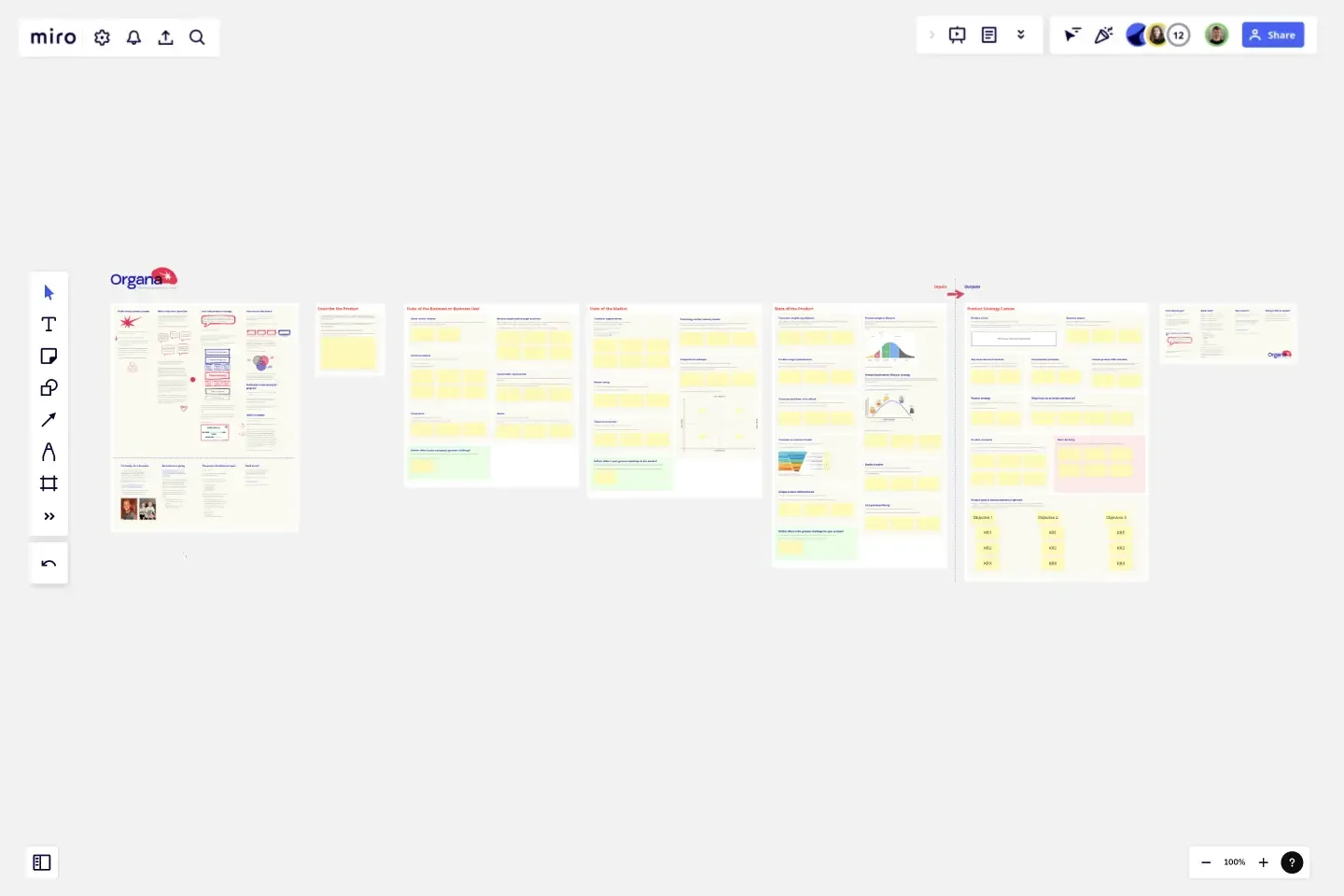Product Strategy Canvas
Creating a product strategy is a job that most product folk do quite rarely, often under pressure and with not enough time.
Because PMs don't create strategies regularly, many of them aren't natural at the process, so when we need to create one, there’s a good chance we freeze. When we recover from the foetal position, we wonder, “where on earth do I start?”
Enter the Product Strategy Canvas: a tool designed to be repeatable, flexible, and lightweight. Drawing inspiration from various successful models, we aimed to simplify the intricate process of strategy creation, catering to those who find it daunting or simply lack time.
We're mindful that one size doesn't fit all. This might be a lot to wrap your head around for junior product professionals or those just starting out in product management. Having said that, knock yourself out and give it a go. If nothing else, you’ll learn a lot. For seasoned directors of product, CPOs, or experienced strategists, you likely have your own approach, but there might be something useful here for you as well.
By streamlining the process and focusing on three critical areas (the state of the business, market and product), you can concentrate on the substance of your strategy and the collaboration it demands.
The canvas serves as a beacon, lifting you from the quagmire of your backlog to provide a clear view of the bigger picture, enabling you to chart a strategic course for your product.
The Product Strategy canvas is a MIRO template that helps product leaders craft a product strategy by following a step-by-step process of gathering data and then using that data to articulate key focus areas that help inform goals, roadmaps, and plans.
This canvas is ideal for Product Managers and Product leaders who wish to follow a repeatable process in order to gather the insights needed to make difficult prioritisation decisions in the form of a Product strategy. This is helpful when you're low on time, do this process rarely and/or wish to approach it collaboratively.
We’ve tested and iterated our canvas with clients, workshop participants, and industry mates and we now proudly share the Product Strategy Canvas in Miro for free under a Creative Commons Licence.
To make the most of this canvas, create a copy and try to fill in each frame without getting stuck. If you don't know the answer, capture the name of someone who does. Once all three input frames are filled in, you should have enough insights to decide on what your team(s) will focus on, in other words, to create a product strategy.
This template was created by Brendan Marsh (Organa).
Discover more product strategy templates to help you build your next big thing.
Get started with this template right now.
Define Your Product's Target Audience
Works best for:
Product Management, Planning
Too broad an audience? Or trying to target too many audiences? This is a certain path to product failure.
Daily Schedule Template
Works best for:
Planning, Project Management
The Daily Schedule Template is a vital tool for managing daily routines efficiently. It helps plan and organize tasks, appointments, and priorities with great precision. Its adaptability allows users to allocate time efficiently, adjust schedules as per changing priorities, and navigate the day with ease. With this template, individuals can integrate daily activities with their broader goals, contributing meaningfully to their overall success.
Calendar 2024 - a Year timeline
Works best for:
Strategy, Planning
The Calendar 2024 a year Timeline template is perfect for planning and organizing your year. It helps you schedule important dates, track annual goals, and stay on top of deadlines. This template ensures you have a clear overview of your year ahead.
Lean Coffee Template
Works best for:
Agile Methodology, Product Management, Meetings
What makes a great meeting (other than donuts)? It’s appreciating everyone’s skills, resources, and time by making the very best use of them. That’s what the Lean Coffee approach is designed to do. Great for team brainstorms and retrospectives, Lean Coffee breaks the meeting into three basic stages: what to discuss, what’s being discussed, and what’s been discussed. This template makes it easy for you to collect sticky notes and to update the columns as you go from topic to topic.
Action Plan Template
Works best for:
Education, Project Management, Project Planning, Kanban
Why create an action plan? Long-term business strategies and goals are only good if you can make them a reality—by accomplishing every small task along the way. An action plan lists those tasks and lays them out in clear detail. It helps you keep everything in order, make sure nothing is missed, and get stakeholders on the same page to complete a project quickly and effectively. This template will help you write an action plan that’s SMART: Specific, Measurable, Actionable, Realistic, and Time-bound.
Product Evolution Canvas
Works best for:
Product Management, Planning
The Product Evolution Canvas template aids product managers in planning and executing product evolution strategies. By mapping out current product features, identifying areas for improvement, and setting evolution goals, this template guides product evolution efforts. With sections for analyzing user feedback, prioritizing enhancements, and tracking progress, it facilitates iterative product development and enhancement cycles. This template serves as a roadmap for evolving products to meet evolving customer needs and market demands.
